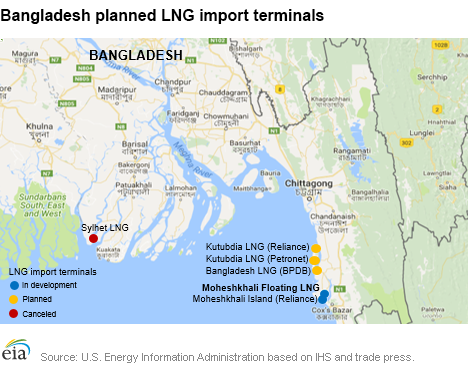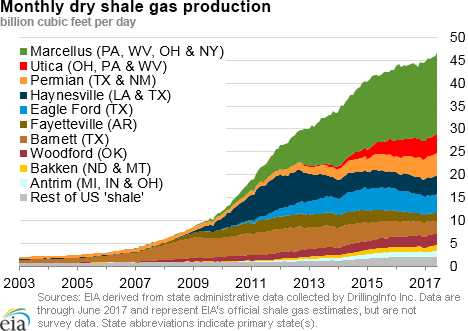In the News:
Bangladesh secures financing for its first regasification terminal, targeting the start of LNG imports by mid-2018
In July 2017, the developers of the first liquefied natural gas (LNG) import terminal in Bangladesh—Moheshkhali Floating LNG project—secured financing and plan to bring the terminal online by mid-2018. The terminal will be jointly developed by Excelerate Energy Bangladesh Limited and the International Finance Corporation and will be located offshore Moheshkhali Island in the Bay of Bengal. The terminal will use a floating storage and regasification unit (FSRU) with a capacity of 0.5 billion cubic feet per day (Bcf/d). The second LNG import terminal, also an FSRU, with a proposed capacity of 0.5 Bcf/d, is being developed by the Summit Group, and is projected to come online by the end of 2018. In addition, three land-based regasification terminals have also been proposed with a combined capacity of 1.96 Bcf/d, but these terminals have not yet secured financing and are unlikely to come online before 2020.
Bangladesh has experienced significant natural gas and electricity shortages over the past decade. The electric generation sector is the largest consumer of natural gas, accounting for 55% of the total consumption. The country is highly dependent on natural gas-fired power generation, which provides 86% of generated electricity. Insufficient domestic natural gas production combined with limited alternative sources of electric power generation have led to widespread power outages and load shedding in the country. In 2016, domestic production of 2.7 Bcf/d was insufficient to meet an estimated 3.3 Bcf/d of natural gas demand, resulting in a 0.6 Bcf/d shortage, according to the Bangladesh government. LNG imports will enable the country to cover this shortage.
In July, Petrobangla (the Bangladesh state-owned oil and natural gas company) signed its first long-term contract for LNG supplies with Qatar for 0.33 Bcf/d, which will begin in 2018 and extend for 15 years. The LNG import price is reported to be linked to the price of crude oil; however, the government will provide subsidies to pay for the imported LNG. The rest of the volumes will be procured on a spot basis. Bangladesh received bids for spot LNG supplies from 10 companies so far and is expected to finalize supplier selection in August.
Future progress of LNG import facilities in Bangladesh will likely depend on the country’s ability to secure multilateral international financing given the capital-intensive nature of infrastructure projects. The government’s latest development plan envisions that 53% of electricity will be generated from coal by 2021, and the development of several coal plants has progressed. While coal-fired generation, which currently accounts for 7% of generated electricity, has the potential to expand its share in the country’s generation mix, expansion of domestic coal production faces public opposition. Also, Bangladesh does not have adequate port infrastructure to import large volumes of coal that would be necessary to supply baseload coal-fired power plants. Should the development of coal plants proceed, it would potentially reduce the demand for LNG imports.
Overview:
(For the Week Ending Wednesday, August 2, 2017)
- Natural gas spot price movements were mixed this report week (Wednesday, July 26 to Wednesday, August 2). The Henry Hub spot price fell from $2.92 per million British thermal units (MMBtu) last Wednesday to $2.77/MMBtu yesterday.
- At the New York Mercantile Exchange (Nymex), the August 2017 contract expired Thursday at $2.969/MMBtu. The September 2017 contract price decreased to $2.811/MMBtu, down 10¢ Wednesday to Wednesday.
- Net injections to working gas totaled 20 billion cubic feet (Bcf) for the week ending July 28. Working natural gas stocks are 3,010 Bcf, which is 9% less than the year-ago level and 3% more than the five-year (2012–16) average for this week.
- The natural gas plant liquids composite price at Mont Belvieu, Texas, rose by 42¢, averaging $6.73/MMBtu for the week ending August 2. The price of natural gasoline, ethane, propane, butane, and isobutane all rose, by 6%, 2%, 9%, 7%, and 8%, respectively.
- According to Baker Hughes, for the week ending Friday, July 28, the natural gas rig count increased by 6 to 192. The number of oil-directed rigs rose by 2 to 766. The total rig count increased by 8, and it now stands at 958.
Prices/Supply/Demand:
Price movements are mixed. This report week (Wednesday, July 26 to Wednesday, August 2), the Henry Hub spot price fell 15¢ from $2.92/MMBtu last Wednesday to $2.77/MMBtu yesterday. At the Chicago Citygate, prices decreased 1¢ from $2.78/MMBtu last Wednesday to $2.77/MMBtu yesterday. Prices at PG&E Citygate in Northern California fell 3¢, down from $3.28/MMBtu last Wednesday to $3.25/MMBtu yesterday. The price at SoCal Citygate increased 34¢ from $3.22/MMBtu last Wednesday to $3.56/MMBtu yesterday. The spot price increased by 35¢ from Friday to Monday, as temperatures in Southern California increased.
Northeast prices rise. Relatively large price increases occurred in the Northeast, as weather forecasts early this week predicted warmer temperatures along the East Coast. At the Algonquin Citygate, which serves Boston-area consumers, prices went up $1.18 from $2.04/MMBtu last Wednesday to $3.22/MMBtu yesterday. The greatest price change at Algonquin was from Friday to Monday, an increase of 82¢. At the Transcontinental Pipeline Zone 6 trading point for New York, prices increased 84¢ from $1.74/MMBtu last Wednesday to $2.58/MMBtu yesterday, with the greatest increase occurring from Friday to Monday.
Tennessee Zone 4 Marcellus spot prices increased 19¢ from $1.65/MMBtu last Wednesday to $1.84/MMBtu yesterday. Prices at Dominion South in northwest Pennsylvania rose 28¢ from $1.64/MMBtu last Wednesday to $1.92/MMBtu yesterday.
On August 2, the Rockies Express Pipeline experienced an unplanned flow reduction on its west-to-east segment, downstream from the Steele City Compressor Station in Gage County, Nebraska. Flows on Segment 260 of the pipeline will be reduced until repairs are completed.
September contract price decreases. At the Nymex, the August 2017 contract expired Thursday at $2.969/MMBtu, up 4¢ from last Wednesday. The September 2017 contract decreased to $2.811/MMBtu, down 10¢ from last Wednesday to yesterday. The front-month contract price fell to $2.794/MMBtu on Monday, the lowest level since the end of February. This decrease occurred as weather forecasts turned cooler for the middle of the country. The price of the 12-month strip averaging September 2017 through August 2018 futures contracts declined 5¢ to $2.946/MMBtu.
Supply remains flat. According to data from PointLogic Energy, the average total supply of natural gas remained the same as the previous report week. Dry natural gas production remained constant week over week. Average net imports from Canada decreased by 2% from last week, but they remain a small contributor to overall supply.
Demand falls. Total U.S. consumption of natural gas fell by 3% compared with the previous report week, according to data from PointLogic Energy. Natural gas consumed for power generation declined by 8% week over week. Industrial sector consumption stayed constant, averaging 19.7 Bcf/d. In the residential and commercial sectors, consumption increased by 21%, or 1 Bcf/d. Natural gas exports to Mexico increased 4%.
U.S. LNG exports increase. Four vessels (combined LNG-carrying capacity of 14.7 Bcf) departed Sabine Pass last week (Thursday to Wednesday).
Cove Point liquefaction facility, which is currently under construction, is reportedly 95% complete, and 90% of the systems at the facility are undergoing commissioning, according to Dominion Energy Midstream Partners’ second quarter earnings call. The facility's operator, Dominion, stated that Cove Point has an agreement with a third party for LNG cargoes that will be produced prior to the terminal's official in-service date later this year, according to SNL Financial.
Sabine Pass Train 4, which has been undergoing commissioning since March has reportedly begun liquefying natural gas, according to Bloomberg. Train 4 is expected to reach substantial completion in November, according to the terminal's operator Cheniere. Natural gas pipeline deliveries to Sabine Pass set a new record in July, averaging 2.19 Bcf/d, 3% higher than the previous monthly record of 2.12 Bcf/d set in April, according to data by Point Logic Energy.
Storage:
Weekly net injections are lower than the five-year average. Net injections into storage totaled 20 Bcf for the week ending July 28, compared with the five-year (2012–16) average net injection of 44 Bcf and last year's net withdrawals of 3 Bcf during the same week. The smaller-than-average net injections this week likely resulted from the warmer-than-normal temperatures in most of the Lower 48 states and increasing cooling demand for natural gas. This pattern was most pronounced in the South Central region, where warmer-than-normal temperatures resulted in net withdrawals from storage totaling 17 Bcf, compared with the five-year average net withdrawals of 1 Bcf in the region. Working gas stocks total 3,010 Bcf, which is 87 Bcf more than the five-year average and 279 Bcf less than last year at this time.
Working gas levels top 3,000 Bcf for the first time since the start of the 2017 refill season. Working gas stocks climbed past the 3,000 Bcf threshold for the first time since January 6, 2017. This is only the third time that working gas levels exceeded this threshold this early in the refill season. However, all three times that working gas levels exceeded this threshold occurred in the past five years. In 2012, working gas stocks reached 3,006 Bcf on June 15, and in 2016 working gas stocks were 3,041 Bcf by June 10. Prior to 2012, working gas stocks typically did not pass this threshold until September.
Net withdrawals from storage are reported in the South Central region for the third week in a row. This week also marks the third week in row that net withdrawals were reported for each of the subregions of the South Central region. Net withdrawals from storage in the South Central region occurred at both salt and nonsalt facilities. Withdrawals from salt facilities totaled 12 Bcf on the week and withdrawals from nonsalt facilities were 6 Bcf. These were the largest withdrawals reported in the South Central region during the refill season. Net withdrawals from storage have been reported at salt storage facilities during six of the past seven report weeks.
So far in the 2017 refill season, net injections into working gas storage are lower than the five-year average in most regions of the Lower 48 states. Net injections into working gas are at 959 Bcf since March 31, 2017—the traditional beginning of the refill season—compared with the five-year average of 1,137 Bcf over the same period. Smaller-than-average net injections to date during the 2017 injection season are the result of high electric sector demand (that was coupled with warmer-than-normal temperatures on average), relatively high levels of natural gas exports, and storage levels that were already above average at the start of the refill season. The East and Mountain regions are the only regions where net injections have exceeded the five-year average. Cumulative net injections during the 2016 refill season in the Lower 48 states totaled 811 Bcf by this time last year, which was also characterized by unusually high storage levels at the start of the 2016 refill season.
The January 2018 futures price continues trading at a premium over the current spot price. During the most recent storage week, the average natural gas spot price at the Henry Hub was $2.96/MMBtu, while the Nymex futures price of natural gas for delivery in January 2018 averaged $3.29/MMBtu, a difference of 33¢. The premium was 54¢ a year ago. The average natural gas spot price at the Henry Hub was 2¢ higher than the front-month futures price at the Nymex. A year ago, the spot price was 4¢ higher than the front-month contract.
Reported net implied flows into storage were close to the median of analysts’ expectations. According to The Desk survey of natural gas analysts, estimates of net injections to working natural gas storage ranged from 14 Bcf to 32 Bcf with a median of 19 Bcf. Prices on the futures contract for September delivery fell 2¢/MMBtu, to $2.82/MMBtu with 631 contracts traded at the release of the WNGSR. Prices for the September contract remained around $2.82/MMBtu in subsequent trading.
Temperatures were warmer than average in most parts of the Lower 48 states during the storage week. Temperatures in the Lower 48 states averaged 77 degrees Fahrenheit (°F), 2°F higher than the normal and 3°F lower than last year at this time. Temperatures were warmer than average in parts of the South Central region, where natural gas-fired electricity generation for air conditioning plays a crucial role in summertime demand for natural gas. Temperatures in the East South Central Census division averaged 82°F, 3°F higher than the normal and 1°F lower than last year at this time. Temperatures in the West South Central Census division averaged 85°F, 2°F higher than the normal and 1°F lower than last year at this time. The New England Census division was the only region reporting cooler-than-normal temperatures. Temperatures in the New England Census division averaged 68°F, 3°F lower than the normal and 7°F lower than last year at this time. Cooling degree days (CDD) in the New England Census division totaled 30, compared to 70 last year and compared to a normal of 45.
See also:
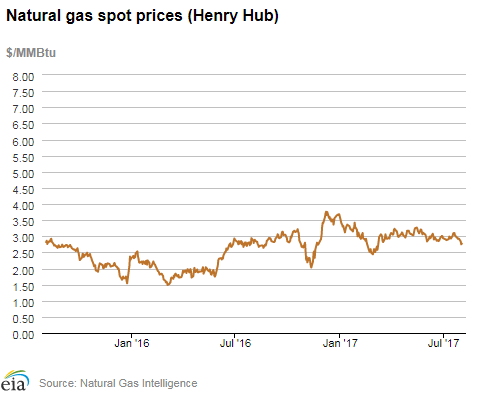
| Spot Prices ($/MMBtu) | Thu, 27-Jul |
Fri, 28-Jul |
Mon, 31-Jul |
Tue, 1-Aug |
Wed, 2-Aug |
|---|---|---|---|---|---|
| Henry Hub | 2.92 |
2.92 |
2.84 |
2.75 |
2.77 |
| New York | 1.89 |
1.73 |
2.68 |
2.70 |
2.58 |
| Chicago | 2.79 |
2.79 |
2.78 |
2.72 |
2.77 |
| Cal. Comp. Avg.* | 2.97 |
2.92 |
3.01 |
2.96 |
2.99 |
| Futures ($/MMBtu) | |||||
| August Contract | 2.969 |
Expired |
Expired |
Expired |
Expired |
| September Contract | 2.967 |
2.941 |
2.794 |
2.819 |
2.811 |
| October Contract | 3.003 |
2.981 |
2.834 |
2.855 |
2.851 |
| *Avg. of NGI's reported prices for: Malin, PG&E Citygate, and Southern California Border Avg. | |||||
| Source: NGI's Daily Gas Price Index | |||||
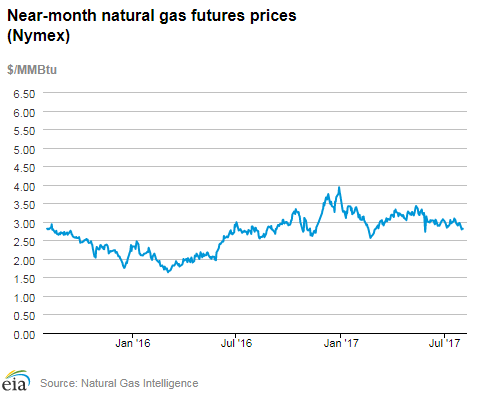
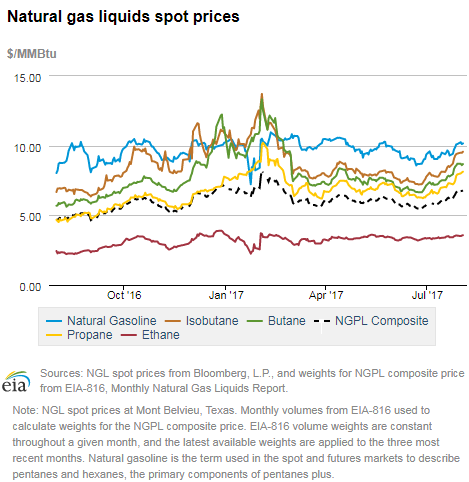
| U.S. natural gas supply - Gas Week: (7/27/17 - 8/2/17) | |||
|---|---|---|---|
Average daily values (Bcf/d): |
|||
this week |
last week |
last year |
|
| Marketed production | 82.0 |
81.9 |
80.7 |
| Dry production | 72.8 |
72.7 |
71.9 |
| Net Canada imports | 6.0 |
6.1 |
7.1 |
| LNG pipeline deliveries | NA |
NA |
NA |
| Total supply | 78.7 |
78.8 |
79.0 |
|
Source: OPIS PointLogic Energy, an IHS Company | |||
| U.S. natural gas consumption - Gas Week: (7/27/17 - 8/2/17) | |||
|---|---|---|---|
Average daily values (Bcf/d): |
|||
this week |
last week |
last year |
|
| U.S. consumption | 60.1 |
62.1 |
64.3 |
| Power | 34.6 |
37.6 |
37.8 |
| Industrial | 19.7 |
19.7 |
19.5 |
| Residential/commercial | 5.9 |
4.9 |
7.0 |
| Mexico exports | 3.7 |
3.6 |
4.1 |
| Pipeline fuel use/losses | 6.5 |
6.7 |
6.9 |
| LNG pipeline receipts | 2.1 |
2.2 |
0.9 |
| Total demand | 72.3 |
74.6 |
76.2 |
|
Source: OPIS PointLogic Energy, an IHS Company | |||
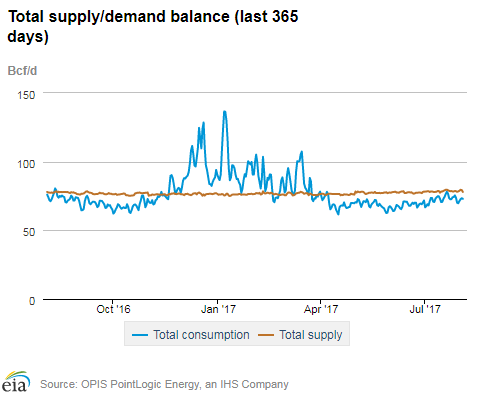
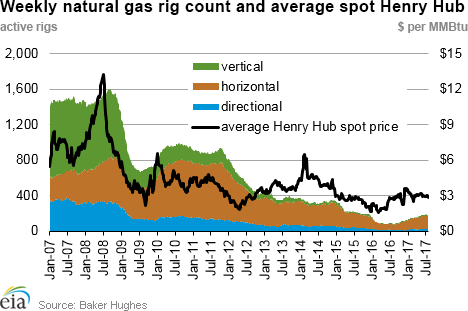
| Rigs | |||
|---|---|---|---|
Fri, July 28, 2017 |
Change from |
||
last week |
last year |
||
| Oil rigs | 766 |
0.3% |
104.8% |
| Natural gas rigs | 192 |
3.2% |
123.3% |
| Note: Excludes any miscellaneous rigs | |||
| Rig numbers by type | |||
|---|---|---|---|
Fri, July 28, 2017 |
Change from |
||
last week |
last year |
||
| Vertical | 71 |
-1.4% |
16.4% |
| Horizontal | 810 |
0.9% |
128.8% |
| Directional | 77 |
2.7% |
60.4% |
| Source: Baker Hughes Inc. | |||
| Working gas in underground storage | ||||
|---|---|---|---|---|
Stocks billion cubic feet (Bcf) |
||||
| Region | 2017-07-28 |
2017-07-21 |
change |
|
| East | 651 |
626 |
25 |
|
| Midwest | 754 |
744 |
10 |
|
| Mountain | 200 |
197 |
3 |
|
| Pacific | 293 |
294 |
-1 |
|
| South Central | 1,112 |
1,129 |
-17 |
|
| Total | 3,010 |
2,990 |
20 |
|
| Source: U.S. Energy Information Administration | ||||
| Working gas in underground storage | |||||
|---|---|---|---|---|---|
Historical comparisons |
|||||
Year ago (7/28/16) |
5-year average (2012-2016) |
||||
| Region | Stocks (Bcf) |
% change |
Stocks (Bcf) |
% change |
|
| East | 727 |
-10.5 |
678 |
-4.0 |
|
| Midwest | 824 |
-8.5 |
724 |
4.1 |
|
| Mountain | 213 |
-6.1 |
175 |
14.3 |
|
| Pacific | 315 |
-7.0 |
327 |
-10.4 |
|
| South Central | 1,211 |
-8.2 |
1,019 |
9.1 |
|
| Total | 3,289 |
-8.5 |
2,923 |
3.0 |
|
| Source: U.S. Energy Information Administration | |||||
| Temperature – heating & cooling degree days (week ending Jul 27) | ||||||||
|---|---|---|---|---|---|---|---|---|
HDD deviation from: |
CDD deviation from: |
|||||||
| Region | HDD Current |
normal |
last year |
CDD Current |
normal |
last year |
||
| New England | 9 |
7 |
8 |
30 |
-15 |
-40 |
||
| Middle Atlantic | 1 |
-1 |
1 |
59 |
0 |
-29 |
||
| E N Central | 1 |
-2 |
1 |
63 |
5 |
-30 |
||
| W N Central | 0 |
-3 |
0 |
89 |
17 |
-13 |
||
| South Atlantic | 0 |
0 |
0 |
112 |
14 |
-6 |
||
| E S Central | 0 |
0 |
0 |
116 |
21 |
-7 |
||
| W S Central | 0 |
0 |
0 |
141 |
15 |
-4 |
||
| Mountain | 0 |
-3 |
0 |
85 |
5 |
-21 |
||
| Pacific | 0 |
-2 |
0 |
61 |
15 |
-14 |
||
| United States | 1 |
-1 |
1 |
85 |
10 |
-17 |
||
|
Note: HDD = heating degree day; CDD = cooling degree day Source: National Oceanic and Atmospheric Administration | ||||||||
Average temperature (°F)
7-Day Mean ending Jul 27, 2017
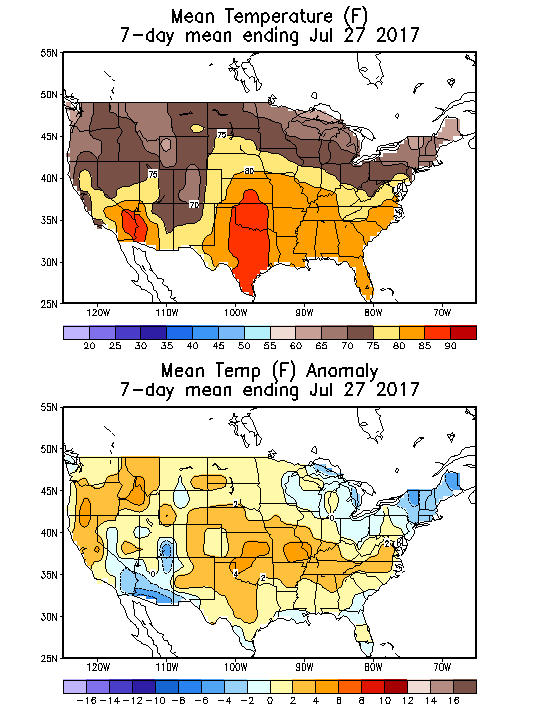
Source: NOAA National Weather Service
Deviation between average and normal (°F)
7-Day Mean ending Jul 27, 2017

Source: NOAA National Weather Service

